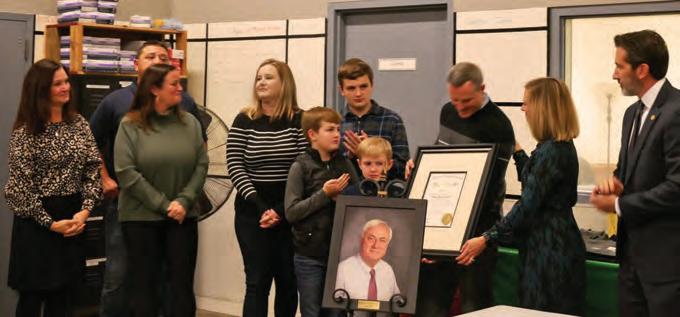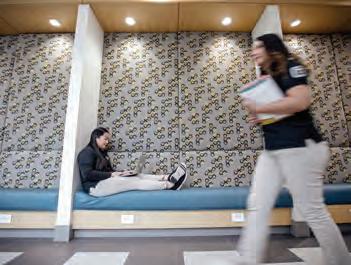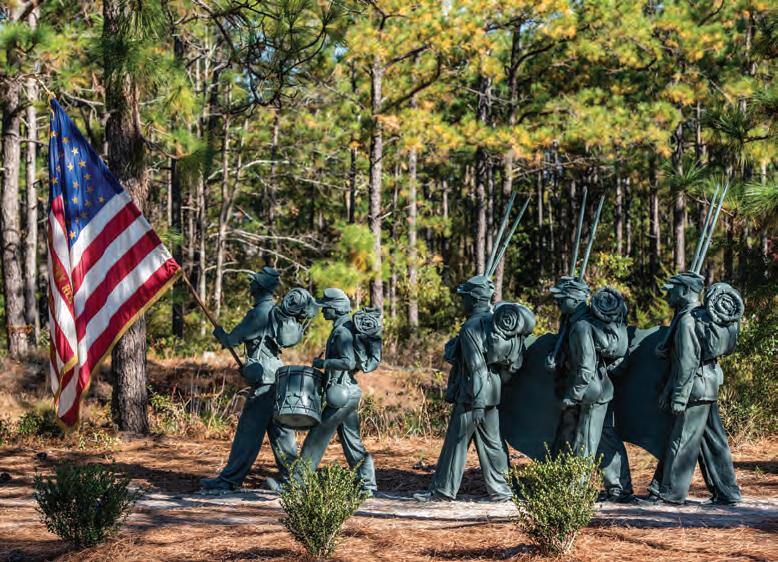
24 minute read
More Power
from 2023-02-BEMC
NC Co-op Assets Pass the Test During Winter Storm
By Amadou Fall
If you’ve been following along in Carolina Country in recent years, you likely have a sense that North Carolina’s electric cooperatives are working together to prepare for a future where we continue our commitment to providing reliable electricity at the lowest possible cost, while also advancing the pursuit of responsible sustainability goals.
Much of the grid innovation you read about in the magazine, and also is discussed by your local electric co-op, plays a part in this transition. And on Christmas Eve and Christmas Day, all of those assets were put to the test. Winter storm Elliott walloped states from Colorado to the East Coast with extreme temperatures, and in some cases wind and blizzard-like conditions. A sudden drop in temperature comes with a sharp and increased demand for electricity as heaters work to keep folks comfortable. As a result, ahead of the storm North Carolina’s electric cooperatives prepared for response to high loads and educated members about the need to conserve electricity. North Carolina Electric Membership Corporation (NCEMC), which provides power to 25 electric cooperatives in North Carolina, began communicating proactively about the storm within the co-op network and with Duke Energy, which provides a portion of our power.
From the electric cooperative perspective, the new grid technologies performed as expected in coordination with existing resources to manage a very challenging situation. We needed and were able to utilize all components of our grid during the extreme weather event: our generation plants, load response programs, battery energy storage systems, and other distributed sources managed by our Distribution Operator service (“Smart, Deliberate Grid Management,” July 2022, page 4).
This is not to say the storm came and went without issue. A regional storm of this size has wide-ranging impacts, and in other parts of the country, several weather-related factors came together to create a situation where, when a sharp and large increase in power was needed in the predawn period of the day to maintain the grid, it simply wasn’t available. Duke Energy implemented rolling service disruptions for the first time in its history — a preventative measure used to avoid potential longer outages on a larger scale. (The Northeast blackout of 2003, which affected an estimated 45 million people across eight U.S. states, is an example of what can happen when demand outpaces supply unchecked.) Members of This storm several electric co-ops across North Carolina underscores the were impacted by the situation. Cooperative substations are interconnected to an expansive importance of transmission grid, and when power to these grid reliability substations is interrupted, so too is electric service to cooperative members. and coordination We thank cooperative members for their of a diverse set of patience and understanding on what was otherwise a joyous holiday weekend, and we deeply supply resources. appreciate all of your efforts to voluntarily conserve power. Electric utilities, including electric co-ops, will learn from this experience in order to enhance service and response times during future storms. This storm underscores the importance of grid reliability and coordination of a diverse set of supply resources. The carefully managed resources and technologies we have implemented passed a critical test, and we are committed to implementing the lessons learned from this latest situation in our future grid planning and operations. Through all of these changes, we will maintain a dedicated focus on providing affordable electricity to our cooperative members, while keeping reliability and resiliency top priorities.
Our easiest Jitterbug® phones ever.
Unlimited Talk & Text
Add a required data plan* .

Unlimited Talk & Text
$1999 month2 Unlimited Talk & Text
Add a required data plan2 .
Large 6.2" screen Simple, list-based menu Voice typing $1999 month2 Video chat Urgent Response button for help, 24/7
Unlimited Talk & Text
$1999 month* Unlimited Talk & Text
Add a required data plan* .
$1999 month* Unlimited Talk & Text
$1999 month2 Unlimited Talk & Text
Add a required data plan2 .
$1999 month2 Unlimited Talk & Text
Large screen and big buttons Easy, list-based menu One-touch speed dialing Powerful speaker Urgent Response button for help, 24/7
EASY The Jitterbug® Flip2 and Jitterbug® Smart3 are our easiest Jitterbug® phones ever. Both have large screens and list-based menus. The Jitterbug Flip2 has big buttons, a powerful speaker, and one-touch speed dialing. With the Jitterbug Smart3, you can voice type emails and texts, video chat and use the internet for maps and directions. SAFE Turn your Jitterbug phone into a health and safety device with Lively® Urgent Response service. Simply press the Urgent Response button to be connected to a certified Agent who will confirm your location, assess the situation and get you the help you need, 24/7. Save over $55 per year when you add Urgent Response and the Lively Link® caregiver app. AFFORDABLE Unlimited Talk & Text plans are just $1999/mo., plus the required data plan for your Jitterbug Smart3. There are no long-term contracts and no cancellation fees.
Save over $55/yr. with a Health & Safety Package.
To order or learn more, call 1.866.991.6840 Save over $55/yr. with a Health & Safety Package. *
Nationwide coverage No long-term contracts
100% U.S.-based customer service and technical support
No hidden Keep your current monthly fees phone number
lively.com/phones
1Discount of $499 applied monthly. Discount not available when you activate on lively.com. 2Monthly fees do not include government taxes or fees and are subject to change. For details on current pricing, visit lively.com. Plans and services may require purchase of Lively device and one-time setup fee of $35. A data plan is required for the Jitterbug Smart3. Urgent Response or 911 calls can be made only when cellular service is available. Urgent Response tracks an approx. location of device when device is turned on and connected to the network. Lively does not guarantee an exact location. Urgent Response and Lively Link are only available with the purchase of a Lively Health & Safety Package. Consistently rated the most reliable network and best overall network performance in the country by IHS Markit’s RootScore Reports. Amazon Alexa integration with Jitterbug Flip2 requires Alexa registration and is subject to Alexa’s Terms of Use. By enabling Alexa on the Jitterbug Flip2, you acknowledge that Lively is not responsible for Amazon Alexa’s functionality or services. Amazon, Alexa and all related logos are trademarks of Amazon. com, Inc. or its affiliates. Screen images simulated. Appearance of device may vary. LIVELY and JITTERBUG are trademarks of Best Buy and its affiliated companies. ©2023 Best Buy. All rights reserved.
Wake Electric’s Privette Posthumously Awarded Order of the Longleaf Pine
Late director’s family received the award on his behalf
On Dec. 8, former Wake Electric Director Rodney Privette was posthumously awarded the Order of the Long Leaf Pine. Since 1963, North Carolina’s governors have reserved the award as the highest honor for persons who have made significant contributions to the state and their communities through exemplary service and exceptional accomplishments.
Privette passed away unexpectedly in August. He had served on the Wake Electric Board of Directors since March 2016. The award was presented to Privette’s family by NC Senator Sarah Crawford and NC Representative Terence Everitt. Donnie Lawrence, current chief of the Rolesville Rural Fire Department, coordinated the presentation, which coincided with the annual meeting for the fire department.
“Rodney’s impact on our community is an inspiring example of leadership to everyone who knows him,” said Wake Electric Board President Suzy Morgan. “As a Rolesville native, Rodney’s community ties ran deep, and Wake Electric celebrates the mark he left on the cooperative as well as public safety and economic development in our area.”
In addition to serving on the Wake Electric Board of Directors, Privette had served as chief of the Rolesville Rural Fire Department since 1992 where he had begun as a volunteer firefighter in 1975. He also served on the Wake County Fire Commission, helped form the Rolesville Chamber of Commerce, served on the board of the Wake Forest Federal Savings & Loan and co-owned Privette Insurance Agency with his sister. He was also a devoted, lifelong member of the Rolesville Baptist Church.
“Rodney filled so many roles in service to his hometown,” said NC Senator Sarah Crawford, as quoted by The Wake Weekly. “And what I knew of Rodney from such a short time, and what I’ve learned since, is that he taught every single one of us what it means to live a life of devotion to others.”
“This prestigious award is a fitting way to recognize and honor Rodney’s legacy and impact on his community and our great state,” Morgan added. “We are proud to see one of our own being honored among North Carolina’s notables.”

(L to R) Privette’s family receiving the award were fiancée Susan Cashion; daughter Brandi Privette and her fiancé Kevin; Niki Privette and grandsons Carson, Hunter and Andrew, and son Coy Privette. NC Sen. Crawford and NC Rep. Everitt presented the award.
In his spare time, Privette would restore old cars, including a 1965 Plymouth Barracuda that was once owned by a U.S. Army soldier who died in Vietnam (“The Compassionate Collector,” May 2020, page 14).


Students: Apply Now for Basketball Camp!
Rising sixth and seventh graders can now apply for a Touchstone Energy Sports Camp Scholarship to attend basketball camp in June. Wolfpack Women’s Basketball Camp NC State University Raleigh Carolina Basketball School The University of North Carolina Chapel Hill
Powering A Brighter Future
North Carolina’s Electric Cooperatives are enhancing reliability and advancing our service to consumer-members with cutting-edge technology as part of our Brighter Future vision.




Learn about our 5 microgrids, 10 battery energy storage systems, 13 solar + storage sites and more.
rural A fresh start for healthcare

Training the next generation of rural doctors
By Sarah Thompson
Before Cannon Memorial Hospital’s labor and delivery unit closed in 2015, Dr. Benjamin Gilmer delivered one of the last babies to be born in an Avery County hospital. The unit where his cousins were born is gone because it was no longer seen as cost-effective to provide obstetrical care in the county, Dr. Gilmer explains.
“We have had more labor and delivery closures per capita than any other region in the country,” Dr. Gilmer says. “This is bad for communities, bad for the economy and certainly bad for women who would like to deliver their child in their home communities.”
Dr. Gilmer is the medical director of the Rural Health Initiative and Rural Fellowship at the Mountain Area Health Education Center (MAHEC), the largest of nine area health education centers in the state, which address the supply, retention and quality of health professionals, particularly in rural communities. Before joining MAHEC, he lived and worked as a doctor in rural North Carolina. He believes that inspiring the next generation of doctors is the best way to help rural places not only survive, but attain health literacy and gain access to specialized doctors educated on social justice in health advocacy.
Counties in need The North Carolina Institute of Medicine describes primary care providers as “the entry point into the health care system.” Access to their care is associated with fewer health disparities and better health among various socioeconomic statuses. The target primary care provider to population ratio should be equal to roughly 6.6 providers per 10,000 patients, according to the Institute. This ratio symbolizes how access to providers improves overall health of communities and can prevent a diagnosis or injury from becoming a NC Primary Care Physicians 2021, by county Greater than recommended minimum of 6.67 per 10,000 patients Below the recommended minimum critical health issue. Yet many rural counties in North Carolina fall far short of this ratio (see map). The gap between access to health providers in rural versus urban counties is not just an inconvenience, it’s causing serious health disparities that doctors like Benjamin Gilmer want students to understand — and want to change.

Rural training Dr. Crystal Gaddy worked in rural healthcare systems for more than 18 years. She has witnessed its shortfalls firsthand. Today, she is an associate professor at Pfeiffer


University’s Master of Science in Occupational Therapy program in Stanly County, where she and other faculty echo the significant need for students to practice medicine in rural areas.
“We’re able to, along with other faculty, really teach and educate our students with the hopes that they will, at least initially or at sometime within their careers, serve those who are really underserved,” Dr. Gaddy says. “From the moment the students enter Pfeiffer’s Occupational Therapy Program, that is the main focus.”
Pfeiffer University’s graduate program in Occupational Therapy (OT) began about two years ago alongside their Physician Assistant (PA) Studies program. As their brandnew building started construction and faculty got together to discuss curriculums, rural health was always a part of the conversation. The most pressing issue discussed was the shortage of health providers in rural regions.
Assistant Professor of Physician Assistant Studies and Randolph EMC member Dale Patterson says that it is extremely difficult to keep providers in rural places. When he’s not at the university, Dale continues to provide clinical care once a week in his local county, Montgomery. At Pfeiffer, students learn about the need for their skills in rural areas, but also the unique opportunities that practicing and living in a rural community can bring.
“The more rural you get, the more difficult it is to retain providers over time,” Dale says. “It can be burdensome on someone over a long period of time if you’re the only provider in office.”
Students discover this for themselves during their required fieldwork. Both the OT and PA programs place students across the country, and the world, to work with health providers and experience what it means to serve and be a part of a community. Dr. Gaddy believes that rural fieldwork is where students get the chance to show off their creativity and critical thinking.
“The best place to be creative is within rural healthcare,” Dr. Gaddy says. “When you have access to everything in the world, you don’t have to critically think as hard. With our students — with us trying to push them within those fieldwork areas and those opportunities in places we call ‘emerging areas’ — it shows them that anything is possible.”
Universities and rural health organizations try to motivate students to practice in rural areas through scholarships, loan forgiveness and other incentives. When Dale was in school, he received a National Health Service Corps scholarship and advises his students to take advantage of those opportunities, which give them more financial freedom to serve communities in need.
Desiring the work Back in Western North Carolina, Dr. Gilmer works 60 to 80 hours a week trying to recruit the newest generation of doctors to practice in rural places. Over the past five years, they’ve placed approximately 30 doctors in western regions of the state. The Rural Health Initiative (RHI) has become the largest recruiter of the health professionals in the mountains and are busy looking to place more psychiatrists, general surgeons and obstetricians.
“Our ultimate goal is for every member of every rural community to have access to a primary care provider,” Dr. Gilmer says. “We want our students and doctors to desire work in rural areas.”
Like Pfeiffer, Dr. Gilmer advises students to look for avenues of support that can ease their transition into rural health systems. He explains the three pillars of support that RHI utilizes to attract and retain health professionals in western North Carolina. First, they talk with high school students to inspire them to give back to their community by becoming a rural care provider. Second, they recruit, train and support students through their schooling by providing scholarships, special training for rural care and connecting them with communities early on. Third, they support practices so that they feel well-capacitated and that they’re a part of a much larger mission.
Hope for the future The work is exhausting yet rewarding. Doctors and local citizens are dedicating their lives to advocate and save lives in rural communities because they know everyone deserves the best care, no matter where they live. These advocates of rural healthcare find solace in those they work with and in the changes they’re seeing in the eyes of their students, patients and communities.
“Everybody wants to give rural communities the health services they need. It’s apolitical,” Dr. Gilmer says. “It’s more than medicine, and we’re just trying to do our part.”
Dr. Benjamin Gilmer
Corey Nolen

Sarah Thompson was a Carolina Country editorial intern in 2022. She is currently pursuing a journalism degree from UNC Chapel Hill.


Alan Cradick Stephen Hayes


Cameron Art Museum
Marching Toward Freedom
Stephen Hayes honors Black history through sculpture
By Vanessa Infanzon
In 2019, the Cameron Art Museum approached Durham-resident and sculptor Stephen Hayes about memorializing the United States Colored Troops (USCT) who marched through Wilmington during the Civil War Battle of Forks Road in 1865. Stephen accepted the challenge to create the memorial.
“This is a super important monument,” Stephen says, a 39-year-old Duke University assistant professor of the Practice of Art, Art History and Visual Studies. “It will tell the history of a story that is untold.”
Stephen’s creation — “Boundless,” a life-size bronze statue of 11 African American men — was unveiled in November 2021 on the grounds where the Battle of Forks Road was fought. The permanent exhibit is also the focal point at the only park in the nation built to honor the United States Colored Troops and their fight for freedom.
“They will be here until the end of time,” Stephen says of the troops. “I use my artwork to change the narrative.”
In the early stages of developing sketches for the sculpture, Stephen immersed himself in the history of the battle by walking the site and meeting the United States Colored Troops reenactors from Battery B 2nd United States Colored Light Artillery, USCT 35th Regiment Tryon Palace New Bern, and the 5th USCT Company C. While in character, these men gave Stephen a history lesson explaining what it was like to march and what kinds of clothing and shoes were worn. These soldiers didn’t have the benefit of making the trek on horses.
Each soldier’s face is based on a real person. At Stephen’s request, the museum put out a call for descendants of the soldiers and reenactors to pose for the sculpture. Stephen casted their faces, using plaster gauze to capture the details in a mold which would later be filled with plaster. The hands were cast from another group of people, veterans and additional descendants of the soldiers.
“The bodies were made from mannequins, dressed in clothing from that time period,” Stephen explains. “I made the clothes flow in the direction of the movement pattern. Then I placed the heads on top of the bodies.”
Unlike most monuments, Stephen intentionally placed “Boundless” on the ground, not on a pedestal. He wants viewers to question how this monument speaks to ones they’ve seen mounted on a tall platform.
“A lot of my work is on the ground so people can be a part of the work,” Stephen says. “These guys marched on the ground. I wanted people to be face to face with my work. I didn’t want it to be on a pedestal so people have to look up and gawk at it.”
Once the plaster mold was ready, Stephen reached out to Carolina Bronze Sculpture, Inc., in Seagrove about casting the piece in bronze. The large multifigure casting was complex, says Ed Walker, president of Carolina Bronze. He and Stephen worked closely together.
“(Stephen) is a visionary,” Ed says. “He can create pieces that have strong statements about societal changes, especially about the plight of African American people. He’s highly respected in my book in his ability to convey those types of images so that people can view and experience his sculpture, and lead with a new sensibility about important social issues.”
Vanessa Infanzon moved to Charlotte for college and never left. When she’s not writing about business or travel, she’s paddle boarding on the Catawba River.


Four Ways to Be Prepared On the Road
Walt Brinker is helping others avoid vehicle breakdowns
By Rue Reynold
A “cheater bar” slipped over the end of a lug wrench provides much more leverage than a lug wrench alone. This method is much safer than standing on a lug wrench handle.
Walt Brinker, a member of South River EMC, is a veteran in Eastover with an extensive history of roadside assistance experience. He has provided over 2,000 assists, been featured on national and local media, and has authored the book “Roadside Survival” in an effort to empower as many as possible to avoid vehicle breakdowns. Walt also teaches Roadside Survival at Fayetteville Technical Community College.
He discusses many vehicle-related problems in his book, from the most common and frequent issues to those that are not so likely to happen, but drivers should know about just in case. Here are four of Walt’s many tips to help you get back on the road when the unexpected happens.
Always have access to your spare tire A flat tire or blowout can happen at any time, including freezing or blistering weather, so be prepared with a spare. If something prevents you from accessing your spare, such as a defective lock key or jammed hatchback, don’t wait to get the problem fixed. Make it a top priority. No access is the same as not having a spare tire. Some cars are also sold without spares, so thoroughly examine any car you’re considering before buying and taking a drive.
Carry a 12-volt air compressor Even if a tire is not in use, it will likely lose 1 to 2 PSI (pounds per square inch) each month. PSI refers to the minimum amount of air pressure needed to support your vehicle at its maximum load, and it’s common to find spare tires — which require 60 PSI to function properly — with low pressure. Keep a portable air compressor to help in a pinch.
Have a 12-volt portable jump starter battery Car batteries tend to die when you least expect it, and common causes are often those that don’t appear harmful, such as leaving your interior lights on or using the sound system while your car is parked or off. Your battery will drain even faster during extreme temperatures, so have a jumper battery pack on hand to revive your dead vehicle.
Maintain your tires regularly Many issues associated with tires develop due to a lack of maintenance. Getting your tires inspected and rotated around every 5,000 miles will give you a real-time analysis of the health and durability of your tires and allow the wheels to be balanced. Regular maintenance helps avoid issues while tending to your tires, such as rusted rims that prevents you from changing a tire.
Learn more Check out roadsidesurvival.com and “Roadside Survival” by Walt Brinker for in-depth explorations and low-tech solutions to all kinds of automobile breakdowns.

Rue Reynold is the editorial assistant for Carolina Country.
How to Exercise Without Gym Equipment

Keep in shape when you live far from a gym
By Rue Reynold
With top-of-the-line equipment that seems to target any part of the body you want, it’s no wonder a gym is a popular workout spot. However, home workouts can be just as effective. Here are a few tips that will keep you in shape without the need for a gym.
Lift those legs Elevating your legs higher than normal when you walk is an everyday gesture you can do to exercise your body. This simple action improves blood flow, reduces inflammation and may lessen swelling.
Home workouts While you may not have equipment found at gyms, home workouts offer the flexibility of targeting areas of the body with the method that works best for you. Exercises at home can range from yoga to strength training to high-impact cardio at any time of day with or without equipment. Tighten your core Engaging your core can be done almost anytime and anywhere. A tightened core reduces strain on the body and decreases the chance of injury, all while burning calories and strengthening muscles. When bracing and tightening your core, it should feel as if your abdominal muscles form a cylinder. Do this while walking, jogging, doing laundry or even sitting at your desk.
Aerobics of your choice Whether you want to keep in shape or burn calories, keeping your body moving is one of the best things you can do, and aerobics is key. Low-impact examples include swimming or walking. To increase the challenge, try jumping rope or running. Aerobics reduces the risk of heart disease, lowers blood pressure and improves lung function.
Rue Reynold is the editorial assistant for Carolina Country.
Love Carolina Country? Don’t miss an issue!
Subscribe and get Carolina Country in your mailbox every month for just $1 an issue!
Co-op Members, check with your electric cooperative to find out if they offer complimentary subscriptions as a benefit of membership.
Yes! Please start my subscription.

NAME
MAILING ADDRESS
CITY STATE ZIP
PHONE NUMBER (If we have questions)
1 Year (12 issues) $12 2 Years (24 issues) $24 Check Enclosed Scan to Subscribe!
February 2023
MEMBER SPOTLIGHT: Fix a Friend Spay Neuter Clinic is Committed to Reducing Pet Overpopulation

Jeannie Leonard, practice manager, co-founder and board member, tells us why it matters:
Kay Griffin, Customer Care Specialist
Fix a Friend was founded by Adopt an Angel, a non-profit dedicated to reducing euthanasia rates in area shelters through aggressive spaying and neutering, and marathon adoption events. We’ve rescued more than 11,000 animals from shelters since 2004, but during that time more than five times that many lost their lives. We realized that we couldn’t rescue them all, there just weren’t enough good homes; we needed to create a high-quality, high-volume, affordable spay and neuter clinic. Board members Sherry Gloer, Jill Jones and I found the land, sketched the building, and following the best practices of the Humane Alliance, Fix a Friend became a reality.
We charge just enough to cover the cost of operating, and we serve the general public, rescue groups and Brunswick County Animal Services. For cats, it’s $55 to spay and $45 to neuter, and for dogs it’s $85 to spay or neuter up to 65 pounds, and slightly more for larger dogs. We have special rates for rescue groups and shelters and also offer a feral cat package, rabies/distemper vaccines and microchips at deeply discounted rates. Brunswick Animal Control can also provide vouchers for spay, neuter and vaccines, which makes it even more affordable. But if it still is out of reach, we try to put people in touch with agencies that can help. We want to spay and neuter for anyone regardless of income.
This wouldn’t be possible without Dr. Amy Eutsey, Dr. Cay Wallis and the rest of the dedicated crew who give their time, talent, energy and effort to making the reduction of pet overpopulation a reality. They impact the community and other agencies in so many ways because indiscriminate breeding is a kaleidoscope event.
Besides the animals themselves, and the rescue groups that are impacted, pet overpopulation puts pressure on animal control and their shelters, resulting in a tax burden on the public. We’re grateful, thanks to our supporters, that Fix a Friend makes a positive difference. Since its founding in 2013, we have fixed more than 90,000 dogs and cats.
Fix a Friend is open MondayThursday with appointments made through fixafriendclinic.org. Donations can be made to Adopt an Angel, 6033 Ocean Highway East, Winnabow NC, 28479, and can be earmarked for Feral Cats or Help a Neighbor.

Bill Buster:
Turn your water heater down to 120 degrees to save on hot water costs. Most are set higher than necessary for normal household needs. In 2005, when BEMC switched over to Automated Meter Reading, the co-op had 65,000 meter locations. Now there are more than 100,000.




